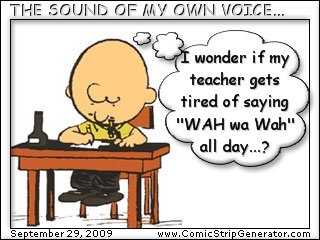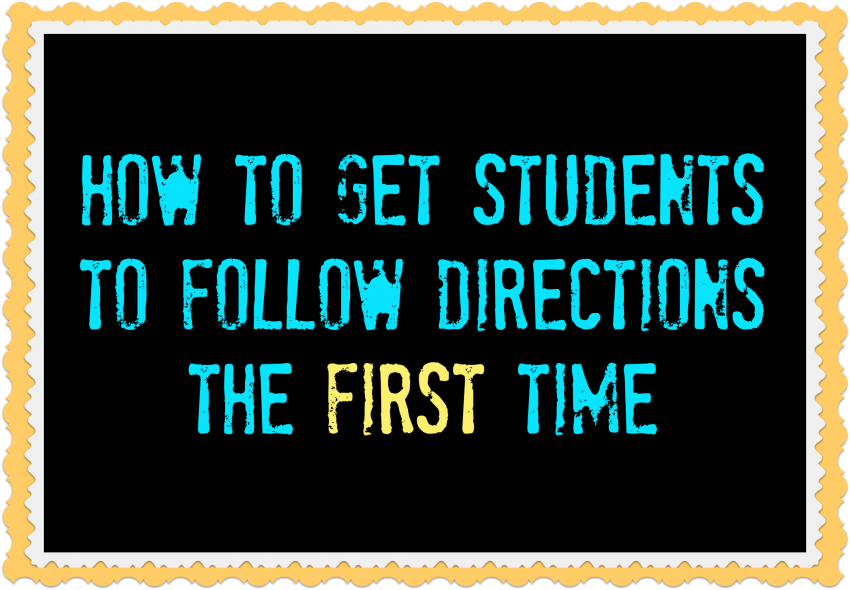By this point in the school year, you’re probably having some moments when you feel like you’ll lose your mind if you have to repeat yourself one. more. time.
Some of you have probably felt like that since September! And that’s perfectly normal. A big part of a teacher’s job is teaching students to listen, follow directions, and be self-directed and independent in their work, and that means LOTS of repetition and reinforcement. It can be exhausting, for sure, so here are some tips to help kids listen to your directions and follow them the first time:

Speak up and say exactly what you need.
There have been many times when I gave directions and heard my students whispering to each other afterward, “What’d she say?” even though I was certain I’d been perfectly clear. Eventually, my husband pointed out my habit of trailing off mid-sentence and assuming people know what I’m talking about.
I realized that I’d often given the first part of a direction to the class, and when the classroom began buzzing with the background noise of students getting materials from their desks and whispering to each other, I assumed they knew what to do and didn’t command the same attention for the remainder of the directions. I’ve had to be very mindful about enunciating and making sure I’ve given the full directions very clearly.
Use a magic word so students don’t move or talk until you’re done giving directions.
This is a wonderful trick for elementary-aged students that I picked up from a co-teacher. Choose a silly word like “pepperoni” or a fun vocabulary word and teach students not to lift a finger until they hear you say it. For example: “When you hear the magic word which is? [class says “pepperoni”), you’re going to get out your math journal, pencil, and eraser. [Pause] Pepperoni.” Young students will listen intently to everything you say in anticipation of hearing the magic word, and you can let kids take turns choosing the magic word for the week to keep their interest up.
Have students repeat directions back to you.
There are several ways you can do this, and I like to switch it up to keep kids on their toes. Sometimes I’ll say, “Tell your partner what the directions are for this activity” and hold up 10 fingers, slowly putting my fingers down one at a time until I’m at zero, then I release students to begin the activity. Other times I’ll have students repeat the directions back to me in unison: “I need you to take out your math book and turn to page 67. Which page? [67] Thank you, go ahead.” I’ve also known teachers who give students a moment of silence to think about the directions and visualize themselves following through.
Write important information in a special place on the board.
Anytime you mention a page number, a time, or any other detail students are likely to forget, make a note of it in a designated section of your board. Then you can simply point to the board or poster instead of repeating yourself. Many students find this extremely helpful, and over time, they will learn to check the board before asking you to give the directions again.
Use a backwards countdown or timer to keep things moving.
Isn’t it funny how something as simple as cleaning up math manipulatives can take ten minutes if you allow it to drag on? The timer is your best friend. Tell kids they’ve got 2 minutes to get everything put away and be prepared for the next activity. You can use a real timer and put it under a document camera for students to see, or project an online timer or timer app on your IWB to display the countdown.
For really short time periods, countdown verbally and show the amount on your hands: “When I get to zero, I need you to have your backpack on and be ready to line up. 10, 9, 8…” When time is up, move on to the next activity just like you said you’d do, and let stragglers catch up without acknowledging them except to help as needed. If you’re consistent with this, students will learn you mean what you say and they have to keep pace!

Give students a purpose for following the directions.
If you want students to open their novels prior in preparation for a discussion, say, “Please turn to page 214 and find the word quintessential. I’d like you put your finger on that word and be prepared to talk about what it means in the context of the paragraph. Ready? Okay, page 214. I’ll know you’re ready when I see your finger on the word quintessential.” If you want groups of students to prepare for a science experiment, ask them to assemble the materials they need and hold up a specific item when they’ve found it–they’ll work more quickly because they won’t want to be the last group to find it.
Ask, “What should you be doing right now?”
When students are off-task, it’s tempting to repeat yourself or nag. Instead, prompt students with questions that require them to think about their choices and the task at hand. Most of the time, students know the correct answer and will either tell you or simply get on task.
Use the 3 Before Me rule.
When students have a procedural question that’s not related to instruction, teach them to ask three other students before they ask you. It’s a great way to get students the information they need without having to say “Yes, I said you can get a drink right now. Yes, you can read your book when you’re done,” over and over again. If you model and practice this effectively, then the next time a student asks “What are we doing right now?” you can simply smile and hold up 3 fingers.
Talk less.
The more students hear your voice, the more likely they are to tune you out, and before you know it, you’ve become the teacher on Charlie Brown. The wake up call for me was when I was actually tired of hearing my own voice. It’s a challenge, but try to speak only when you have something important to say, and resist the urge to fill every moment of instruction with commentary. Remember: the person doing the most talking is the person doing the most learning, so that role should go to the kids.
How do you help students follow directions? What tips and tricks work in your classroom?
My Favorite Classroom Management Resources on Pinterest
Follow Angela Watson’s Teaching Ideas’s board Classroom Management on Pinterest.

Angela Watson
Founder and Writer
Sign up to get new Truth for Teachers articles in your inbox
Discussion
OR

Join our
community
of educators
If you are a teacher who is interested in contributing to the Truth for Teachers website, please click here for more information.
















Plan your instructions before class begins. Make “crip” notes for yourself to be sure you don’t “overspeak” the instructions. BUT, before you begin the instructions for the activity; first, have the students clear their desk of everything. THEN, tell them what they will need to follow your instructions and have them put those items back on their desk. Give precise and concise instructions. When you have finished, ask for questions. Wait quietly for a full two minutes for questions before you let them begin. If they ask for instructions after work begins, pleasantly remind them the time for questions has passed and turn away to a task that breaks the engagement with that child. I had many colleagues who used the ask three before me rule. I’m not convinced that teaches children to take responsibility for paying attention during instructions.
Thanks for your comment. Do you find that students get frustrated when they ask you for directions and you tell them that the time for questions has passed and turn away? What do they do at that point to get their question answered?
I would assume they either just try to figure it out on their own (essentially asking themselves what the instructions were) or they ask a friend. This is the same thing that the 3 Before Me Rule teaches: ask yourself, then ask others. The only difference is that instead of telling the student they can’t ask you a question right now, you’d be giving them a strategy they can use to figure out what to do.
They are “crib” notes.
There is a failsafe which I did not mention. Except on tests, they have a redo option available. When a paper clearly demonstrates that they did not follow instructions, I wrote “Redo. Please see me for instructions.” I will then privately go over the instructions again. Also, during instructions, I teach them to code instructions that are on the paper, I will have them underline the word “underline” in the instructions, draw a circle around the word circle in the instructions, or write the word “words” where it is fill in the blank. On math papers, we coded the instructions using the operational sign above the instructions. I don’t recall a single student having more than one redo for instructions. I was amazed, however, that we had very few redoes after the first week. When we had a new student transfer in, we did a class wide orientation where the students told the new student what was so important to know about classroom expectations as they explained the class rules. I came to that after seeing it in the class of one of my co-operating teachers in my teacher ed program. It really taught them to take power over their learning opportunities. Their questions, after the first week of school, were really thoughtful and sometimes even showed me omissions in my instructions. When that happened, I always thanked them for pointing it out to me and we discussed the improvement I needed to make in my instructions. Their subsequent teachers always knew my students because of that. The year I had to take maternity leave after only six weeks into the year, the supply teacher complained to me because they reminded her of the coding routine. She was not happy with me but my regular subs loved it.
Hi Angela,
Another trick I learned from my master teacher (13 years ago) was, when the class needed to come back together from group work or when the noise was getting a little too juch, is to stand near the front, or middle, of the classroom, and say in a soft conversational voice, “If you can hear my voice, clap once”. Usually, five or six close students will clap. Then I say, “If you can hear my voice, clap twice”. Usually half the class will clap twice. Rare are the moments when I have gotten to “If you can hear my voice, clap three times”. By this time, most students are waiting what other interactive, low-risk activity will come next. To change this up, I’ve asked them to stand up, turn around, jump once, twice, sit back down, etc.
Thank you for your suggestions. I have five periods of high school seniors coming at me in four weeks. I need all the help I can get.
-Dann Lealos
Great tips both for the classroom and home! A strange question but there is a picture with the article that had dividers for missed work. Do you have that? If so, where did you get it? Thanks again!
I needed this! Thank you so much for the terrific ideas.